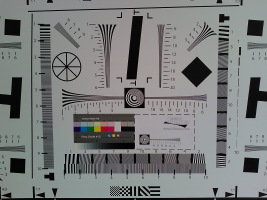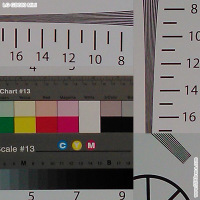LG GD880 Mini review: Going minimalist
Going minimalist
Disappointing audio quality
Unfortunately one of the corners that LG had to cut in order to make the LG GD880 mini concerns the audio quality. The LG GD880 mini is by far not the loudest handset around but its audio output isn't too clear either.
The extreme bass frequencies have been cut-off, while the distortion levels are way too high. The signal-to-noise ratio is also far from spectacular and so is the dynamic range. All this adds up to one of the worse performers we have seen recently and the LG GD880 mini is certainly not to be recommended to audiophiles.
Check out its performance compared to some of the other handsets we have tested in the table below.
| Test | Frequency response | Noise level | Dynamic range | THD | IMD + Noise | Stereo crosstalk |
| LG GD880 mini | +0.36, -4.09 | -59.9 | 59.9 | 1.183 | 1.012 | -72.2 |
| LG BL40 New Chocolate | +0.25, -3.04 | -85.9 | 87.8 | 0.030 | 0.341 | -81.3 |
| LG KM900 Arena | +0.09, -1.61 | -91.6 | 91.7 | 0.0017 | 0.101 | -90.4 |
| Samsung S8000 Jet | +1.01 -2.03 | -87.9 | 87.0 | 0.015 | 0.060 | -85.9 |
| Sony Ericsson W910 | +0.25, -1.25 | -81.5 | 82.7 | 0.0071 | 0.028 | -81.9 |
| HTC HD mini | +0.15, -0.68 | -83.7 | 86.7 | 0.024 | 0.158 | -84.1 |
| Apple iPhone 3GS | +0.01, -0.05 | -92.1 | 92.1 | 0.0035 | 0.011 | -95.0 |

LG GD880 mini frequency response graph
You can learn more about the testing process here.
5 megapixel photos will do
The GD880 Mini sports a 5 megapixel camera. It's capable of taking photos at maximum resolution of 2560 x 1920 pixels and offers geotagging, face tracking and smile detection.
The Mini comes with a camera interface similar to what the previous LG full-touch handsets offered. It’s slightly improved since but still has some to catch up with the best on the market.
Our main regret is that you need to go to the advanced settings to access most of the customizable options. You get the virtual buttons for exposure compensation, digital zoom, focus modes and the camera/camcorder switch onscreen at all times but that’s that.
The improvement mentioned is mostly in the fact that the rotating settings dial now shows five settings at a time. We still seem to prefer Samsung’s approach but the difference isn’t as great now.
In the advanced settings you will find image quality options, white balance, color effects, picture size, scenes, etc. There are also ISO settings and focus options in case you are into using them.
The LG GD880 Mini produces nice photos with decent levels of detail and pleasant colors. The noise levels are tolerable, though sometimes they can be a bit higher than usual. In some places there's extreme oversharpening, but it's rare enough and definitely something you can live with. There are aspects that clearly need some more work, but our overall feeling about the image quality remains positive.
Synthetic resolution
We also snapped our resolution chart with the Mini. You can check out what that test is all about here.


LG GD880 Mini resolution chart photo • 100% crops


Samsung S8000 Jet resolution chart photo • 100% crops
Video recording
Unfortunately, the video recording is not quite the LG GD880 Mini element. The handset pulls of the passable VGA-resolution videos but the choppy framerate (15fps only) takes most of the fun out of them.
Here is a sample VGA video clip.
Rich connectivity options
Wireless connectivity support is complete on the LG GD880 Mini. Quad-band GSM/GPRS/EDGE is on board and so is the dual-band (900/2100 MHz) 3G with HSDPA 7.2 Mbps and HSUPA 2 Mbps support.
The phone also supports plenty of local connectivity standards – Bluetooth, USB and Wi-Fi are all on board. The Bluetooth version is 2.1 with A2DP support for stereo streaming and 802.11b/g for Wi-Fi.
WLAN is set up via a simple interface - you choose the desired network, type the pass key and voila - you're connected. Of course there are plenty of advanced options available for the geeks out there.
The last and most important thing is that every installed Java application, which requires internet access prompts you to choose between UMTS and Wi-Fi, which is a great option.
LG have their own sync service now – the LG Air and they are introducing it along with the LG Mini. You need to create an account on your desktop browser, then log in on your device, authenticate it and start the sync process. We added our Google exchange account and it imported all of our contacts and calendar events. The interface is very simple, but the sync service gets the job done and that’s more than enough.
Mass storage mode is supported when you connect a microUSB cable but you can also remove the microSD card and transfer data through a card reader you have at hand. It’s not quite as convenient but it gives you better speed if you are to, say, copy several gigabytes worth of data.
The standard 3.5mm audio jack lets you plug in your favorite pair of headphones but you'll have to live without the microphone, as the original pair is one-piece.
Reader comments
- Neuza
- 03 Aug 2012
- Le}
bristolboyO2 was advertising it and the sntsaeion xe in the metro and other papers with a full page advert plus get free headphones if buying direct from o2! All that advertising costs though hence the high selling price!
- Mira
- 03 Aug 2012
- 0vS
I've had Froyo on my Galaxy S for months! It's dlerveied by your carrier, NOT Samsung, so instead of whinging about Samsung not updating, get onto your service provider Btw, I haven't had any problems with mine (aside from the GPS lock) however I re...













